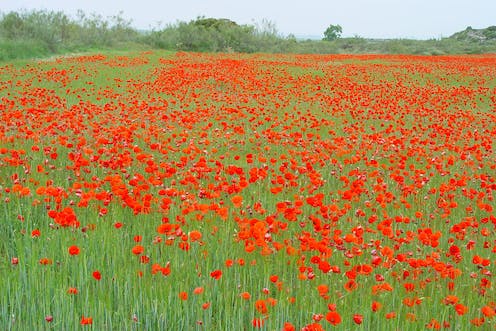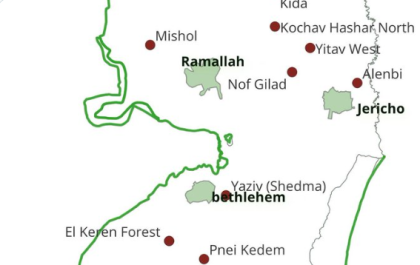Poppies in a cereal field. Jordi Recasens Guinjuan, Author provided
Spring is here and many fields of crops are dotted with red poppies. Farmers know that this is not a good sign, even if hundreds of people show up, mobile phones in hand, in search of the best photograph.
Poppies, along with other species that grow in fields, can be a problem for crops if they appear in large numbers. We informally call them weeds, but what are they really and how bad are they?
Impersonators of cultivated plants
Weeds are generally annual or pluri-annual herbaceous plant species that are adapted to environments that are frequently disturbed, such as fields of crops. Their survival strategy is to resemble the crop as much as possible, to maximise their chances of survival and reproduction. To accomplish that, they germinate, flower, or mature at times similar to the crop, or they have a similar growth strategy.
There are species that are highly adapted to the winter grain cycle, such as the poppy (Papaver roheas) and annual ryegrass (Lolium rigidum). Others, such as lamb’s quarters (Chenopodium album) and redroot pigweed (Amaranthus retroflexus), are adapted to summer crops (for example, corn), which have rainwater or irrigation available.
Woody fields such as olive groves and vineyards also have their own species like wall-rocket (Diplotaxis spp.). In these cases, the plants are more adapted to management (harvesting, tilling) and not so much to the timing of the crop itself.
From the point of view of their adaptive strategy, weeds are plants that thrive in fertile environments that are regularly disturbed, a strategy defined as “type R”, for “ruderal”. Fields of crops are one of the primary places where these conditions occur. The high levels of fertility are provided by manure or fertilisers and the disturbances include working the soil, harvesting, chipping, and/or the application of herbicides.
A species of wall-rocket (Diplotaxis catholica).
Jordi Recasens, Author provided
Weeds: are they always bad?
Because they grow in the same places as crops, weeds compete for space, light, and resources such as water and nutrients. It is estimated that, worldwide, these plants can reduce harvests by up to 30%. They are the organisms that cause the most losses, even more than pests and crop diseases.
Apart from crop losses, weeds can reduce the quality of the harvested product (grain or forage contamination), transmit diseases to crops, and make agricultural tasks more difficult.
However, some species and their seeds also contribute to providing ecosystem services. For example, they contribute to biodiversity, host beneficial insects and pollinators, feed birds, and reduce erosion at certain times of the year.
So, then, what determines if a plant is a weed? Although this is a complex question, the answer lies in the plant’s density and time of growth, its competitiveness with the crop in question, and its seed production. The latter will determine the persistence of the problem in successive years.
It is true that some very competitive species (like cleavers, Galium aparine) can, in turn, promote ecosystem services by harbouring a vast array of beneficial insects. However, the more aggressive and dominant species are not usually the ones that are best at providing these positive effects.
Cleavers (Galium aparine).
Jordi Recasens, Author provided
Consequences of improper handling
For a plant to become a “weed”, it must thrive in fields of crops, and that is where the paradox comes in: many of the most competitive and aggressive weeds are often this way due to inappropriate management. For example, an excessive use of herbicides along with poor crop rotation has promoted, in several species, the selection of biotypes that are resistant to these chemical products. This has aggravated their impact on crops and it makes control options more difficult.
Likewise, an excessive use of fertilisers has favoured, in some cases, the development of very competitive species adapted to such scenarios. This is the result of the great degree of resilience of these plants; that is, their ability to adapt and perpetuate themselves when faced with the different changes that come about through their management.
In most cases where weeds cause major yield losses, one or just a few species that are functionally very similar to each other are the culprits. This means that these species have similar germination times or a similar growth strategy and resource assimilation. For example, in grain fields, we can look at annual ryegrass, wild oat (Avena sterilis), and the poppy. Likewise, in corn fields, noteworthy are lambs quarters, black nightshade (Solanum nigrum), and foxtail (Setaria spp.).
Wild oat (Avena sterilis) and poppies (Papaver roheas) in a grain field.
Jordi Recasens, Author provided
These species are the ones that manage to pass through all the “filters” put in place by the environment (temperature, rainfall/irrigation, etc.) and crop management (working the fields, herbicides, etc.). They are the most competitive species and displace others.
To try to control them, we sometimes fall into the trap of upping the pressure against them, using the same tools (more doses of herbicides, more work in general) and not leaving behind the very system that allowed for their presence in the first place (like monoculture). There are many good reasons why farmers act this way, but the truth is that sometimes this mentality only makes the problem worse.
Can we live with weeds?
To get out of this vicious circle, it is necessary to diversify – not just crops, but also soil-management tactics, weed-control tools, harvest times, and even mentalities.
Over the medium and long term, the diversification of agroecosystems also results in the diversification of weed communities. Some recent studies confirm that the greater the diversity of weeds, the less competitiveness the resulting community has with the crop. The more species coexist in one place, the lower the probability is of there being a dominant species.
It is worth asking ourselves if we could design weed communities that are less competitive. That is where we are at: trying to design productive agroecosystems in which management goes hand in hand with the ecological processes that govern the life of crops (and also weeds).
Bàrbara Baraibar Padró receives funding from the Beatriu de Pinós postdoctoral programme of the Secretary of Universities and Research (Generalitat de Catalunya) and from the European research and innovation programme Horizon 2020 under the Marie Sklodowska-Curie covenant number 801370.
Jordi Recasens Guinjuan receives funding from the Spanish Ministry of Science and Innovation and the State Research Agency, through public calls, to develop research projects.
Related posts
SÍGUENOS
Trump avisó a las petroleras del ataque a Venezuela
Cuando la guerra se decide en consejos de administración y el Congreso sobra
Colonias para enterrar Palestina
La aprobación de 19 nuevas colonias judías en Cisjordania no es una anomalía, es una política de Estado sostenida por armas, dinero y silencio internacional.
La Tierra se encamina a perder 100.000 glaciares mientras continúa la inacción política
El calentamiento global no es una abstracción científica, es una cuenta atrás con nombres, fechas y consecuencias irreversibles
Vídeo | La DANA que arrasó Valencia y la política que se escondió detrás de una mochila
Marina Lobo desmenuza el caos, las mentiras y la cadena de irresponsables
La mentira humanitaria: cómo Occidente troceó Sudán para después fingir sorpresa
Quinndy Akeju explica la historia que los titulares evitan


 Seguir
Seguir
 Seguir
Seguir
 Seguir
Seguir
 Subscribe
Subscribe
 Seguir
Seguir




